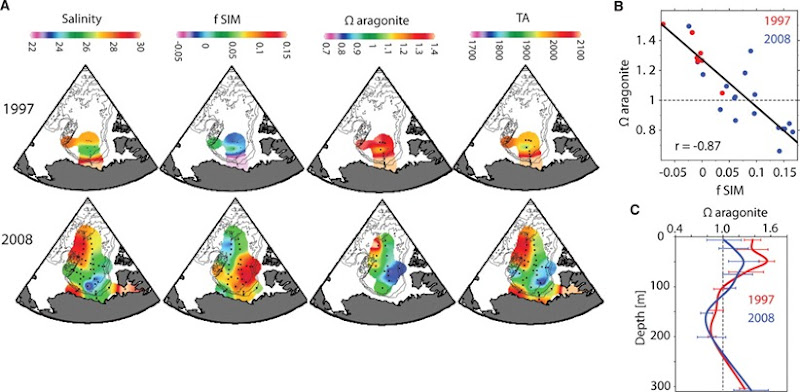Graph of the Day: Arctic Ocean Aragonite Saturation, 1997 and 2008
(A) Surface distributions of Ω aragonite, S, fraction of sea ice meltwater (f SIM), and TA in surface water observed between depths of 0 and 20 m. f SIM was estimated by using
18O and S measurements (12, 13). Gray contour lines indicate isobaths of 1000, 2000, and 3000 m. (B) Relationship between Ω aragonite and f SIM in surface water observed in 1997 (red) and 2008 (blue). (C) Mean vertical profile of Ω aragonite in the upper 300 m of the Canada Basin in 1997 (thick red line) (14) and in 2008 (thick blue line). Observations at stations where the bottom depth was >2000 m were used to calculate mean and SD (error bars) at each depth. ABSTRACT: The increase in anthropogenic carbon dioxide emissions and attendant increase in ocean acidification and sea ice melt act together to decrease the saturation state of calcium carbonate in the Canada Basin of the Arctic Ocean. In 2008, surface waters were undersaturated with respect to aragonite, a relatively soluble form of calcium carbonate found in plankton and invertebrates. Undersaturation was found to be a direct consequence of the recent extensive melting of sea ice in the Canada Basin. In addition, the retreat of the ice edge well past the shelf-break has produced conditions favorable to enhanced upwelling of subsurface, aragonite-undersaturated water onto the Arctic continental shelf. Undersaturation will affect both planktonic and benthic calcifying biota and therefore the composition of the Arctic ecosystem. …
Michiyo Yamamoto-Kawai, Fiona A. McLaughlin, Eddy C. Carmack, Shigeto Nishino, Koji Shimada, Aragonite Undersaturation in the Arctic Ocean: Effects of Ocean Acidification and Sea Ice Melt , Science 20 November 2009: Vol. 326. no. 5956, pp. 1098 – 1100 DOI: 10.1126/science.1174190
